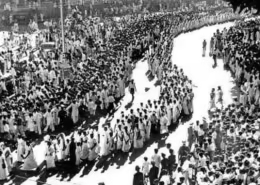How does Quit India movement differ from Non -Cooperation movement in the terms of its objectives,outcomes and strategies?
The Quit India Movement, launched by Mahatma Gandhi on August 8, 1942, was a significant event in India's struggle for independence from British colonial rule ¹ ². The movement's impact and effects on British colonial rule in India can be summarized as follows: Impact of the Quit India Movement: AntRead more
-
Anti-colonial struggle: The Quit India Movement was a massive anti-colonial struggle in India, launched under the leadership of Mahatma Gandhi ¹.
-
Civil disobedience: The movement was initially started as a civil disobedience movement, but it soon took a violent turn with the aim of ‘fight to the finish’ of the colonial empire ¹.
-
Nationwide participation: The movement saw nationwide participation, with people from all over India joining in the protests and demonstrations ².
-
British response: The British responded with force, arresting tens of thousands of leaders and imprisoning them until 1945 ².
-
Weakening of British rule: The Quit India Movement weakened British colonial rule in India, making it difficult for the British to maintain their hold on the country ².
-
Shift in British policy: The movement led to a shift in British policy, with the British government realizing that India was ungovernable in the long run ².
-
Path to independence: The Quit India Movement is considered a significant step towards India’s independence, which was finally achieved in 1947 ¹ ².
-
Inspiration to other movements: The Quit India Movement also inspired other movements for independence across the world ².


Here's a breakdown of the key differences between the Quit India Movement and the Non-Cooperation Movement: Objectives: Non-Cooperation Movement (1920-1922): This aimed to achieve swaraj (self-rule) for India through non-violent resistance. It focused on withdrawing cooperation from the British goveRead more
Here’s a breakdown of the key differences between the Quit India Movement and the Non-Cooperation Movement:
Objectives:
Non-Cooperation Movement (1920-1922): This aimed to achieve swaraj (self-rule) for India through non-violent resistance. It focused on withdrawing cooperation from the British government by boycotting British goods, educational institutions, and legal systems.
Quit India Movement (1942): This demanded an immediate British withdrawal from India. It aimed for complete independence, not just self-rule within the British Empire.
Outcomes:
Non-Cooperation Movement: The movement was called off due to the Chauri Chaura incident where a police station was burnt down by protestors. While it did not achieve immediate independence, it did:
Quit India Movement: The movement was met with brutal suppression by the British. However, it did:
Strategies:
Non-Cooperation Movement: This movement relied on non-violent protests, boycotts, and strikes. It aimed to disrupt the British administration and economy through peaceful means.
Quit India Movement: This movement had a more confrontational approach. While still advocating for non-violence, it aimed for mass civil disobedience and potentially a large-scale uprising against British rule.
In essence, the Non-Cooperation Movement was a more cautious step towards self-rule, while the Quit India Movement was a bolder call for immediate independence. The Non-Cooperation Movement focused on non-violent protest and boycotts, while the Quit India Movement was open to the possibility of a more widespread uprising.